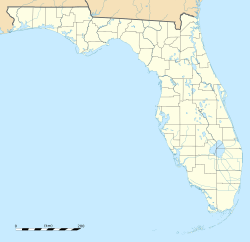John F. Kennedy Space Center MPS facts for kids
Quick facts for kids |
|
|
John F. Kennedy Space Center MPS
|
|
| Location | Titusville, Florida |
|---|---|
| MPS | Historic Cultural Resources of the John F. Kennedy Space Center, Florida |
| NRHP reference No. | 64500111 |
The Kennedy Space Center (KSC) in Florida is a very important place for space travel. Many of its buildings and areas are considered historic. This means they are special and protected because of their role in history. These places are listed on the National Register of Historic Places. This list helps make sure important sites are kept safe for future generations.
The buildings and areas listed below are part of a special group called a Multiple Property Submission (MPS). This is like a collection of related historic places that are all recognized together. You can find a full list of these historic places on KSC's Environmental Planning website.
Exploring Kennedy Space Center's Historic Sites
The Kennedy Space Center is home to many amazing structures that helped us reach for the stars. These sites are located in Titusville, in Brevard County, Florida. They were added to the National Register of Historic Places on different dates, recognizing their importance to space history.
Central Instrumentation Facility
The Central Instrumentation Facility is a key building at KSC. It was added to the historic list on January 21, 2000. This facility played a big role in controlling and monitoring space missions. It helped make sure everything worked correctly during launches and other important operations.
The Crawlerway
The Crawlerway is a special road at Kennedy Space Center. It was added to the historic list on January 21, 2000. This wide, gravel path is used by giant machines called crawler-transporters. These machines slowly carry rockets and spacecraft from the Vehicle Assembly Building to the launch pads. It's an amazing sight to see!
Headquarters Building
The Headquarters Building is where many important decisions about space missions are made. It was added to the historic list on December 1, 2000. This building is the main office for the Kennedy Space Center. It's where leaders and teams plan and manage all the activities related to space exploration.
Launch Complex 39
Launch Complex 39 is one of the most famous launch sites in the world. It was added to the historic list on May 24, 1973. This complex includes the giant launch pads where many Apollo missions to the Moon and Space Shuttle flights began. It's a place where history was made again and again.
Launch Complex 39-Pad A
Launch Complex 39-Pad A is one of the two main launch pads within Launch Complex 39. It was added to the historic list on January 21, 2000. Many historic rockets, including those for the Apollo Moon missions and Space Shuttle flights, lifted off from this very pad.
Launch Complex 39-Pad B
Launch Complex 39-Pad B is the other main launch pad at Launch Complex 39. It was also added to the historic list on January 21, 2000. Like Pad A, this site has seen many powerful rockets launch into space, carrying astronauts and satellites on important missions.
Launch Control Center
The Launch Control Center is a very important building located next to Launch Complex 39. It was added to the historic list on January 21, 2000. From here, engineers and scientists monitor every step of a rocket launch. They make sure everything is perfect before giving the "go" for liftoff.
Missile Crawler Transporter Facilities
The Missile Crawler Transporter Facilities refer to the giant machines that move rockets. These facilities were added to the historic list on January 21, 2000. The crawler-transporters are enormous vehicles that slowly carry rockets and their launch platforms to the pads. They are some of the largest land vehicles ever built.
Operations and Checkout Building
The Operations and Checkout Building is where spacecraft and their parts are put together and tested. It was added to the historic list on January 21, 2000. Before a mission, astronauts would often get ready here. This building is crucial for preparing everything for space travel.
Press Site-Clock and Flag Pole
The Press Site-Clock and Flag Pole is a well-known spot where news reporters gather to watch launches. It was added to the historic list on January 21, 2000. This site offers a great view of the launch pads. The clock counts down to liftoff, and the flag pole stands tall as rockets soar into the sky.
Vehicle Assembly Building
The Vehicle Assembly Building (VAB) is one of the largest buildings in the world. It was added to the historic list on January 21, 2000. This massive building is where the biggest rockets and spacecraft are put together vertically. It has both a High Bay, for very tall rockets, and a Low Bay, for other assembly work.



